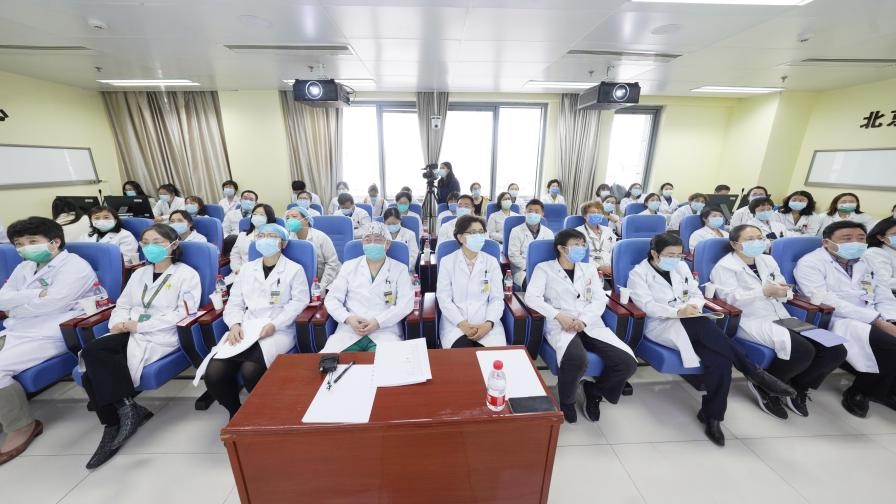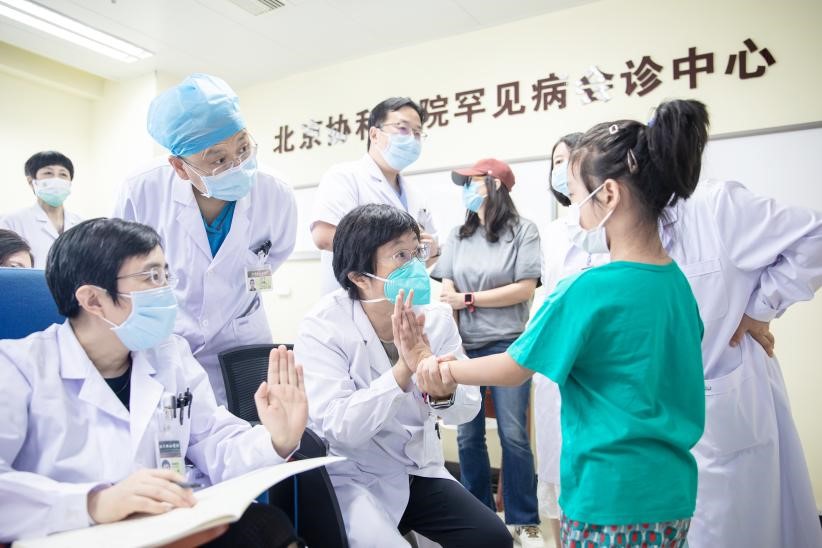"Did the reticulocyte count increase or decrease? Have further tests been done for hemolytic and nutritional anemia?" "When did the complementary feeding start?" "Can you hold the child's hands and feet up in front of the camera for us?" At 12:00 am, on Thursday, August 4, 2022, the Center for Intractable Disease Consultation on the fourth floor of the outpatient building in PUMCH was packed with crowds. Dozens of experts and professors from different departments gathered here to conduct a remote consultation, analyze the condition, and formulate a treatment plan for a three-year-old child with recurrent infections, growth retardation and suspected neurodegenerative disorders and acrodermatitis enteropathica. For them, every Thursday’s MDT is a seemingly usual, but essentially unusual practice. On one hand, they are making an all-out effort regardless of how intimidating the disease is, just the way every PUMCH doctor will do. What makes their endeavor unusual is that the diseases they are facing have extremely low incidence and excessively complex pathogenesis, for which treatment plan is still unchartered waters. Because of these features, these conditions are known as rare diseases.
Multidisciplinary Collaboration to Challenge the "Small Medical Probabilities"
Rare diseases are also called orphan diseases because of their extremely low incidence. Up till today, there are more than 7,000 known rare diseases worldwide and over 300 million patients. The patient population in China is no less than 20 million.
Behind these figures are patients and their families who are embroiled in an uphill struggle for treatment. In clinical practice, rare diseases are associated with a wide range of disciplines such as hematology, orthopedics, neurology, kidney, respiratory, dermatology, cardiology, endocrinology, etc. Due to complex conditions and scarce cases, multidisciplinary coordination between clinical teams, medical experts and geneticists is indispensable for accurate diagnosis, making rare diseases very difficult to be diagnosed.
If a correct diagnosis is the first step in treatment, many patients have spent all their time, energy, money and even life before they reach this crucial step. Statistics from the China Alliance for Rare Diseases reveal that the time of diagnosis for 15.5% of rare disease patients is 1 to 4 years, while 5% need to wait for 5 to 20 years to be diagnosed, and 42% have experienced misdiagnosis. The average time of diagnosis is 4.26 years.
With the hard work of PUMCH, the time of diagnosis is rapidly shortening by a measurement of year, month, and week.
As the only national leader of the National Rare Disease Collaborative Network (hereinafter referred to as the Collaborative Network), PUMCH has joined hands with 32 provincial hospitals and 291 member hospitals to provide centralized treatment and two-way referral for rare disease patients in China and established the first national rare disease consultation platform in 2019, dedicated to providing one-stop treatment solutions for rare disease patients in China.
A typical rare disease MDT meeting is initiated by the attending physician, who will deliver a case presentation and provide examination videos, imaging studies, test results, pathological images, genetic profiles, etc. Then, the MDT expert team will hold in-depth discussions after reviewing the patient, analyzes the condition and reach a diagnosis. In the end, a moderator will summarize and formulate a detailed guiding treatment plan. As of August 4, 2022, 164 patients have received the consultation service provided by the MDT Consultation Center for Rare Diseases at PUMCH.
The first patient who benefited from the Collaborative Network and the Rare Disease MDT is a three-month-old infant named Niu Niu. The mother was aware of reduced fetal movement in late pregnancy and the baby was born with hypotonia. A municipal hospital in Shandong Province provided supportive treatment but no significant improvement was seen, so the kid was referred to Shandong Provincial Hospital, one of the provincial initiators of the Collaborative Network. Tests indicated the possibility of Prader-Willi Syndrome, and the patient was referred to PUMCH, the national leading hospital of the Collaborative Network. After detailed examination and careful consultation, the MDT team at PUMCH reached a diagnosis and proposed a comprehensive early intervention plan. The diagnosis of this three-month-old infant is undoubtedly a miracle compared to the long-winded journey that rare disease patients had to endure.
Such multidisciplinary collaboration has never hit the pause button despite the impact of COVID-19. On February 29, 2020, which is the 13th International Rare Disease Day, a multidisciplinary remote consultation on rare diseases was held under the theme of Gather in Love, organized by the China Alliance for Rare Diseases, PUMCH and West China Hospital of Sichuan University. More than 40 doctors from 6 hospitals and 11 specialties in Beijing, Sichuan, Shandong and Hebei conducted multidisciplinary teleconsultations for 5 rare disease patients. Professor Zhang Shuyang, then Vice President of PUMCH, also participated in the consultation via remote connection, although she was at the front line of the fight against the pandemic in Wuhan.
On February 28, 2021, the 14th Series Events on Rare Disease Day held at PUMCH. More than 100 doctors from PUMCH, West China Hospital of Sichuan University, the Second Affiliated Hospital of Zhejiang University School of Medicine and Xuanwu Hospital of Capital Medical University participated via teleconference and conducted remote consultations for many patients.
The joint efforts of top experts at PUMCH have secured valuable time for the diagnosis and treatment of rare disease patients. "Through the consultation platform, the average diagnosis time was reduced from 4 years to 4 weeks, and the cost was cut down by 90%." said Zhang Shuyang, President of PUMCH.
Small Steps Lead to Big Changes, Rare Disease Specialists Are No Longer Rare
Scarce as rare diseases are, doctors of this field are even more scarce. The lack of expertise among primary doctors on how to identify and diagnose rare diseases is a hindrance to the improvement of diagnosis and treatment. Therefore, it is of particular significance to improve the understanding of rare diseases and promote standardized treatment.
For many doctors at PUMCH, each MDT of rare diseases is an excellent learning opportunity because they are deeply inspired by the teaching of the old generation of PUMCHers—learn and grow from cases.
On July 28, 2022, a patient suffering from anti-GAD antibody-associated neuroimmune syndrome (stiff person syndrome, cerebellar ataxia) combined with vitiligo received comprehensive treatment from more than twenty departments at PUMCH. After the case presentation delivered by Department of Neurology, experts from other departments such as radiology, nuclear medicine, rheumatology, and endocrinology shared their views. The Department of Ophthalmology summarized the ocular manifestations of anti-GAD antibody-related neurological diseases. The Department of Dermatology reviewed the relationship between vitiligo and systemic diseases. The Department of Rehabilitation provided home exercise therapy for cerebellar ataxia, and the Department of Psychological Medicine summarized the psychological and behavioral changes of anti-GAD antibody-related neurological syndrome. Extending from individual cases to the recognition, diagnosis, treatment strategies, rehabilitation recommendations, and all-round body-mind care for a particular disease has become the norm in MDT for rare diseases.
The systematic analysis, heated discussions, and in-depth communication expanded the participants' knowledge and understanding of this disease. Online attendees from the members of the Collaborative Network were also observing the process of this patient's diagnosis and treatment, drawing replicable experience from the individual case.
Based on the profound understanding of rare disease diagnosis and treatment, PUMCH has been promoting talent cultivation in the field of rare disease by tapping into the Collaborative Network. Since the establishment of the network, PUMCH, as the leading organization, has hosted more than 50 training sessions in 22 cities across China, which covered 81 diseases and influenced over 100,000 doctors. This has greatly enhanced the understanding of rare diseases and standardized treatment ability among medical personnel in China.
Unleash Cascading Effect, Build a National Health Support Network for Rare Disease Patients
Thanks to a strong team of experts, an efficient collaborative approach, and an ever-improving working mechanism, PUMCH and its sister institutions of the Collaborative Network, unafraid of hardship and unhindered by distance, continues to set new records in the treatment of rare disease patients in China, and join hands to build a national health support network for rare disease patients.
In October 2019, two adult patients with spinal muscular atrophy (SMA) visited PUMCH, expecting to use nusinersen, a medication for SMA gene therapy, which had just been approved for marketing in China. However, it had been over 25 years since the initial onset and both patients suffered from complex scoliosis, with only slight movement of the upper limbs. The adoption of prevalent operation abroad would mean multiple radiation exposures for doctors and patients. Moreover, the prone position would be very difficult for the patient with scoliosis. Therefore, the choice and dosage of medication as well as the long-term treatment became a matter that required thorough deliberation.
After discussions, the MDT team of PUMCH and dozens of experts from other hospitals decided to conduct ultrasound-assisted intrathecal injection of nusinersen administration and formulated a detailed follow-up treatment plan. In the same month, after thorough preparation, PUMCH completed the world's first intrathecal injection of nusinersen (medication for SMA gene therapy) administration for these two adult SMA patients, which was also the first of its kind in China with the application of ultrasound visualization technology.
PUMCH’s exploration and valuable experience is benefiting more and more SMA patients. In April 2022, the People's Hospital of Tibet Autonomous Region (TAR), the provincial initiator of the Collaborative Network in TAR, joined hands with PUMCH, completed the intrathecal injection of nusinersen administration for Mr. Sang, an adult Tibetan patient suffering from SMA. This has not only raised hope among SMA patients in Tibet, but also marks a milestone in the treatment of rare diseases in Tibet.
With the joint efforts of PUMCH and the members of the Collaborative Network, a nationwide network for rare disease prevention and treatment has taken shape, unleashing the cascading effect of high-quality medical resources, which is a big step towards the goal of "early detection, early diagnosis, treatment and management" of rare diseases. The establishment of standards and management systems characterized by two-way referral, specialist rounds and remote consultation among the hospitals of the Collaborative Network has greatly facilitated the continuity of the patient journey which ranges from screening, diagnosis and treatment to rehabilitation and follow-up.
As a trailblazer and builder of the collaborative system of rare disease diagnosis and treatment in China, PUMCH has opened the door to hope for rare disease patients by not giving up on any patient and forging ahead against odds. PUMCH has full confidence that more miracles will be created in the treatment of rare diseases in China with the care and support of the government as well as the joint efforts of the hospitals in the Collaborative Network.

Rare disease MDT meeting

Experts of different specialties examine children with rare diseases
Written by: Li Yuanjing and Chen Mingyan
Picture courtesy: Sun Liang
Translator: Liu Haiyan
Editor: Wang Yao
